As a sequel of this question, I built a mathematical model for the Id current of the following (same) JFET circuit:
For a simplified model, I took LAMBDA=0 and set the internal resistances Rd=0 and Rs=0. I then proceeded to calculate the roots for Vg_limit (the value of the input voltage that takes the JFET to the limit between saturation and triode regions) and Id_sat (the drain current in the saturation region). For simplification, I didn't consider the triode region in this analysis.
After doing some math, the roots for the Vg and the equation for Id_sat are obtained as:
$$Vg_{limit} = \dfrac{2 \beta R_{ds} V_{dd} \pm \sqrt{4 \beta R_{ds} V_{dd} + 1} + 1}{2 \beta R_{ds}^2} $$
$$Id_{sat} = \dfrac{2 \beta R_{s} V_{gt} \pm \sqrt{2 \beta R_{S} V_{gt} + 1} + 1}{2 \beta R_{s}^2} $$
where $$ R_{ds} = R_d + R_s \quad and \quad V_{gt} = V_g - V_{to}$$
Out of the two roots for each equation above, only one makes sense physically.
I tested this for many NJF models from LTspice and, while it worked for quite a few, I faced some discrepancies for some other devices, in which the BETA was particularly low.
As an example, if I take a simplified version of the 2N4118A, you can see from the plots below that Id_sat from the model is totally different than the one from SPICE. Moreover, the Vds - Vgst curve doesn't touch the origin, which should happen, as the circuit is fed with a sine wave having amplitude equal to Vg_limit.
Can you maybe spot what I'm doing wrong here? As I mentioned, this works for other devices, in which the BETA is larger. As a matter of fact, if I replace the value in this model with a higher one (0.4m or higher, instead of 0.095m), the plots start to match.
Another funny fact that I noticed was that, when increasing the temperatures to absurdly high values, for instance 250ºC, the plots also start to match. Strange indeed, as I forced BETATCE=0 and VTOTC=0.
Here is the PySpice code:
import numpy as np
import matplotlib.pyplot as plt
from PySpice.Spice.Netlist import Circuit
from prefixed import Float
def main():
F0 = 20 # [Hz]
FS = 48000 # [Hz]
temp_c = 25 # [celsius]
T = 0.1 # [seconds]
# Ground truth: spice model
circuit = Circuit('JFET')
my2N4118A = circuit.model("my2N4118A", "NJF",
Beta="0.095m",
Betatce="0",
Vto="-1.299",
Vtotc="0",
Lambda="0",
Rd="0",
Rs="0",
)
# component values
VDD = 9.0
RG = 1E6
RD = 4.4E3
RS = 1E3
RDS = RD+RS
jfet_spice_params = {
p.upper(): my2N4118A._parameters[p]
for p in my2N4118A._parameters
}
BETA = Float(jfet_spice_params["BETA"])
VTO = Float(jfet_spice_params["VTO"])
# Roots for ID at the limit region, where
# ID - BETA * (VDS)**2 = ID - BETA * (VDD - ID * RDS)**2 = 0
id_limit = np.array([
(2*BETA*RDS*VDD - np.sqrt(4*BETA*RDS*VDD + 1) + 1)/(2*BETA*(RDS**2)),
(2*BETA*RDS*VDD + np.sqrt(4*BETA*RDS*VDD + 1) + 1)/(2*BETA*(RDS**2))
])
vd = VDD - id_limit * RD
vg = vd + VTO
vs = id_limit * RS
vds = vd - vs
if (id_limit[0] > 0 and vds[0] > 0) and (id_limit[1] <= 0 or vds[1] <= 0):
vg_limit = vg[0]
elif (id_limit[1] > 0 and vds[1] > 0) and (id_limit[0] <= 0 or vds[0] <= 0):
vg_limit = vg[1]
else:
vg_limit = None
print("Error! VG limit sanity check failed")
# Netlist
circuit.V('Vdd', 'vdd', circuit.gnd, VDD)
circuit.SinusoidalVoltageSource(
'in', 'gate', circuit.gnd, amplitude=vg_limit, frequency=F0)
circuit.R('Rg', 'gate', circuit.gnd, RG)
circuit.R('Rd', 'vdd', 'drain', RD)
circuit.R('Rs', 'source', circuit.gnd, RS)
circuit.J('JFET', 'drain', 'gate', 'source', model="my2N4118A")
plt.figure()
plt.title('Id x t')
# Spice model
simulator = circuit.simulator(
temperature=temp_c, nominal_temperature=temp_c)
# analysis = simulator.dc(Vin=Vsl)
analysis = simulator.transient(step_time=1/FS, end_time=T)
vin_spice = np.array(analysis["gate"])
vgs_spice = np.array(analysis["gate"]) - np.array(analysis["source"])
id_spice = (np.array(analysis["vdd"]) - np.array(analysis["drain"])) / RD
vgst_spice = vgs_spice - VTO
vds_spice = np.array(analysis["drain"]) - np.array(analysis["source"])
# if > 0 then saturation, else triode
v_limit_spice = vds_spice - vgst_spice
t = np.array(analysis.time)
# Roots for IDsat, when LAMBDA = 0
vgt = vin_spice - VTO
BETA_2 = 2 * BETA
BETA_2_RS_VGT = BETA_2 * RS * vgt
# Out of the 2 existent roots, only the one with "- np.sqrt(...)" makes sense physically
id_sat = (BETA_2_RS_VGT - np.sqrt(2 * BETA_2_RS_VGT + 1) + 1) / \
(BETA_2*(RS**2))
id_sat[vgt <= 0] = 0
plt.plot(t, id_spice, label="Id_spice")
plt.plot(t, id_sat, label="Id_model")
plt.xlabel('T [s]')
plt.ylabel('Id [A]')
plt.margins(0, 0.1)
plt.grid(which='both', axis='both')
plt.legend()
plt.figure()
plt.title('V x t')
plt.plot(t, vgst_spice, label=f"Vgst")
plt.plot(t, v_limit_spice, label=f"Vds-Vgst")
plt.xlabel('T [s]')
plt.ylabel('V [V]')
plt.margins(0, 0.1)
plt.grid(which='both', axis='both')
plt.legend()
plt.show()
if __name__ == "__main__":
main()


